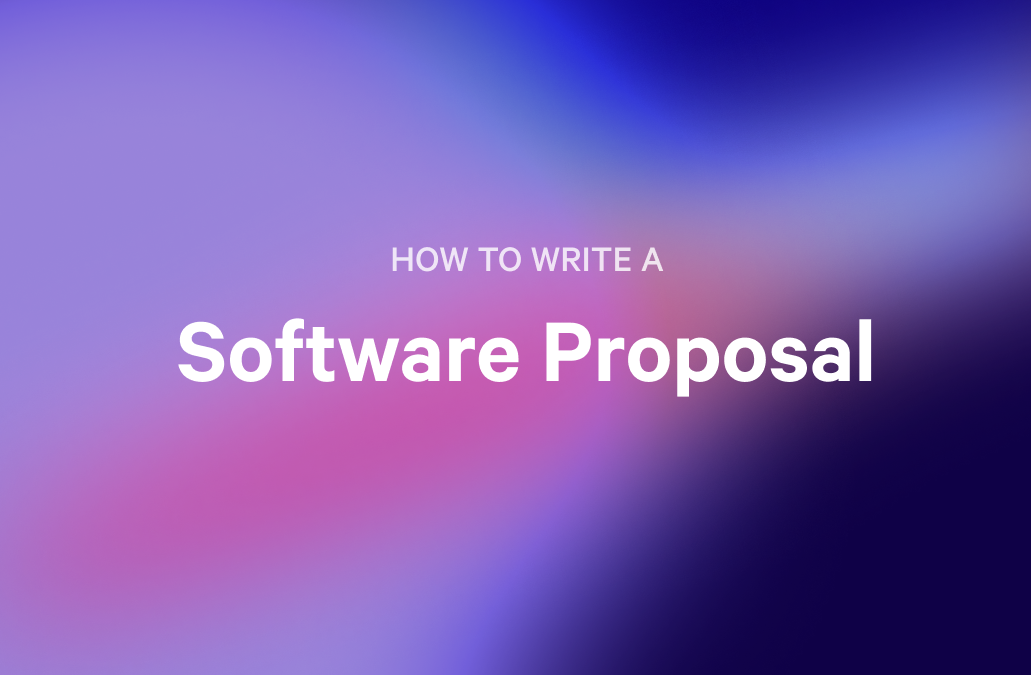Whether implementing new software, upgrading hardware infrastructure, or adopting cutting-edge technologies, the need for well-crafted technology proposals has never been more critical. A compelling proposal outlines the technical specifications and articulates the value proposition, cost-benefit analysis, and implementation strategy.
However, crafting a winning technology proposal is no easy feat. It requires a blend of technical expertise, strategic thinking, and effective communication skills. From understanding the client's needs to presenting a comprehensive plan of action, every aspect of the proposal plays a crucial role in securing buy-in from stakeholders and ultimately driving successful project outcomes.
In this guide, we will delve into the intricacies of writing technology proposals that stand out and resonate with decision-makers. Whether you're a seasoned IT professional or a newcomer to the world of proposal writing, this comprehensive resource will equip you with the tools and techniques needed to craft compelling proposals that win contracts, drive innovation, and propel your organization forward.
Key takeaways
- A well-crafted technology proposal requires technical expertise, strategic thinking, and effective communication skills.
- Understanding the audience's needs and pain points is crucial in crafting a resonating proposal.
- A compelling proposal should clearly define the problem, present a unique solution, and detail the implementation plan.
- Showcasing success stories and providing a transparent breakdown of costs and ROI can boost the proposal's credibility.
- Including a clear and compelling call to action is essential to guide the audience towards the next step.
What is A Technology Proposal?
A technology proposal is a document that outlines a plan or solution for implementing technology-related initiatives within your prospect's organization.
It typically includes details such as the objectives of the proposed technology project, the scope of work, technical specifications, timeline for implementation, budget considerations, the proposed team members and their experience, and potential benefits to the organization.
Technology proposals are often used to seek approval, funding, or support for software development, system upgrades, network infrastructure improvements, cybersecurity enhancements, and digital transformation initiatives.
The content and format of a technology proposal may vary depending on the project's specific requirements and the preferences of the target audience. However, regardless of the specifics, a well-written technology proposal should clearly articulate the problem or opportunity being addressed, present a detailed plan for implementing the proposed solution, and demonstrate the potential return on investment or other benefits for the organization.
Steps to write a technology proposal: Key elements to include
Let's break down this journey into key elements that will ensure your proposal doesn't just get noticed but will be remembered.
Step #1: Understand your audience
Before you even type a word, take a moment to consider your audience. Who are you talking to?
Are they tech-savvy visionaries or intimidated by too much jargon and tech-speak? Your proposal should be in their language. Tailor your message so it resonates with them, addressing their needs and pain points. This step sets the tone for everything that follows so don't skimp here.
Step #2: Define the problem clearly
Now, let's get to the heart of the matter. What problem does the technology solution outlined in your proposal solve? Be specific. A vague problem leads to a vague solution. Use real-world examples or data to illustrate the issue. This isn't just about stating the problem; it's about making your audience feel the urgency of solving it.
Step #3: Present your solution
Here's where the magic happens. Introduce your technology not just as a solution but as the solution. Highlight what makes it unique and superior to any existing alternatives. Remember, “features tell; benefits sell”: focus on how your technology will improve their business or life, backed by clear, quantifiable benefits.
Step #4: Detail the implementation plan
You've got their interest; now show them the way forward. Outline a clear, step-by-step plan for implementing your technology within their existing systems or processes. Timelines, milestones, and any required resources should be clearly laid out. This demonstrates not only feasibility but also your commitment to a partnership, not just a sale.
Step #5: Showcase success stories
Nothing builds confidence like success. Include case studies or testimonials from past clients who have benefited from your technology. Real-world examples of your solution in action can significantly boost your proposal's credibility. It's proof that you're not just making promises but delivering results.
Step #6: Address costs and the ROI
Now for the numbers talk. Provide a transparent breakdown of costs, but don't stop there. Highlight the return on investment (ROI) your technology offers. This could be in the form of cost savings, efficiency gains, or revenue growth. Make it clear that investing in your technology and services provided isn't a cost; it's a smart business decision.
Step #7: Include a Call to Action
Finally, what do you want them to do next? Don't leave your audience hanging. Whether scheduling a demo, a follow-up meeting, or simply reaching out for more information, your call to action should be clear and compelling. You've made your case; now give them the nudge to take the next step.
Example of a technology proposal template
A technology proposal template ensures you include all the pertinent details and can be a huge time-saver in the creation process. Qwilr's technology proposal template is easy to customize, delivering a visually impressive experience that complements your content and captivates your client.
Here’s what our project proposal template includes:
Title Page
First impressions matter, and this is how your proposal makes a strong one. Start with a clean, professional page that includes your proposal's title, the date, and both your company's and the potential client's names and logos.
Executive Summary
Think of this as your elevator pitch on paper. In a concise paragraph or two, summarize the essence of your proposal: the problem, your unique solution, and the benefits your solution offers. The executive summary should captivate and compel your reader to dive deeper.
Problem Statement
Here, you're setting the scene. Describe the problem in a way that has your reader nodding along, thinking, "Yes, that's exactly the issue we're facing." Use data, anecdotes, or scenarios to paint a vivid picture of their challenges while demonstrating your full understanding of it.
Your Solution
Now, introduce the hero — your technology. Describe how it addresses the problem outlined earlier, focusing on benefits rather than features. How will your solution change their world for the better? Be persuasive, be specific, and above all, be clear about the value you're offering.
Implementation Plan
Details, details, details. Lay out the roadmap for integrating your solution into their operations. Include timelines, milestones, and any necessary resources or changes. This section reassures the reader that you've thought through the logistics and are committed to a seamless transition.
Case Studies and Testimonials
This is where you show you can be successful—don't just tell your prospect. You will do this by presenting case studies or testimonials that demonstrate your technology's success in similar scenarios. This is where your proposal moves from promise to proof, providing tangible evidence of your solution's effectiveness.
Pricing and ROI
Here you will present the costs associated with your solution clearly and straightforwardly. But don't stop there—highlight the return on investment. Whether it's through efficiency gains, cost savings, or revenue growth, show that your technology is not a purchase but an investment in their future success.
Conclusion and Call to Action
Wrap things up with a strong, persuasive conclusion reiterating your technology's value. Then, clearly state what you want the reader to do next. Make it easy for them to take the next step, whether it's contacting you for a demo, setting up a meeting, or signing on the (virtual) dotted line.
Contact Information
Don't forget to include your contact details. Make it as easy as possible for them to reach out with questions or start your partnership's next phase.
Final Thoughts
Crafting a standout technology proposal is both an art and a science. It's about blending the technical with the tangible to paint a compelling picture of a future made better with your solution. As we wrap up this guide, I want you to remember a few key takeaways that could make the difference between a proposal that's merely read and one that's acted upon.
- Firstly, know your audience like the back of your hand. The more you understand their needs, fears, and aspirations, the more tailored and impactful your proposal will be. This isn't just about selling a product; it's about offering a solution to their unique problem in a language they understand and appreciate.
- Secondly, clarity and concision are your allies. In a world flooded with information, being able to convey your message clearly and compellingly is invaluable. Your proposal should be easy to read, understand, and remember.
- Thirdly, focus on the benefits, not just the features. Your technology might have all the bells and whistles, but what your audience really wants to know is how it will improve their lives or businesses. Show them the future — a future that's brighter with your technology in it.
- Lastly, always end with a clear call to action. Don't leave your audience wondering what to do next. Whether it's a meeting, a demo, or a simple conversation, guide them toward the next step in the journey you're hoping to embark on together.
As you craft your proposals, keep these principles in mind, and you'll not only capture attention — you'll capture hearts and minds. And, on that note, why not try our technology proposal template? It guarantees a proposal as visually impressive as its content is persuasive. And saves a whole heap of time, to boot.
About the author

Marissa Taffer|Founder & President of M. Taffer Consulting
Marissa Taffer is the Founder & President of M. Taffer Consulting. She brings over 15 years of sales and marketing experience across various industries to a broad range of clients.
Frequently asked questions
The best format is clear, concise, and engaging. Use headings, bullet points, and short paragraphs to break up text and make your proposal easy to scan. Visual aids like charts, graphs, and images can help illustrate your points and keep the reader engaged.
There's no one-size-fits-all answer here. The key is balance. You want to provide enough detail to make a compelling case for your technology but not so much that it becomes overwhelming. As a rule of thumb, aim for brevity and relevance. If you can say it in fewer words without losing impact, do so. Remember, your goal is to keep the reader engaged and interested, not to bury them in pages and pages of text!
In technical proposal writing, personalization is key. Tailor your proposal to address your prospective client's specific needs, challenges, and goals. Use their language and reflect their company culture. Incorporating testimonials or case studies that resonate with their industry can also make your proposal more relevant and compelling. Lastly, don't shy away from creativity. Whether it's a unique format, engaging visuals, or a memorable opening, find ways to leave a lasting impression.
Yes, but do so wisely. The technical specifications are important, but they should not overshadow the benefits and value your solution provides. Include them in a way that's accessible to non-technical readers. Use appendices for detailed technical specs or data so they're available for those who want to dive deeper without cluttering the main narrative of your proposal.
Be transparent but also strategic. Highlight the value and ROI of your solution upfront. When presenting the pricing, frame it within the context of the benefits and cost savings over time. If your solution is more expensive than others, justify the difference through its unique advantages. Remember, your proposal should make the case that investing in your technology is not just justified but essential for their success.


